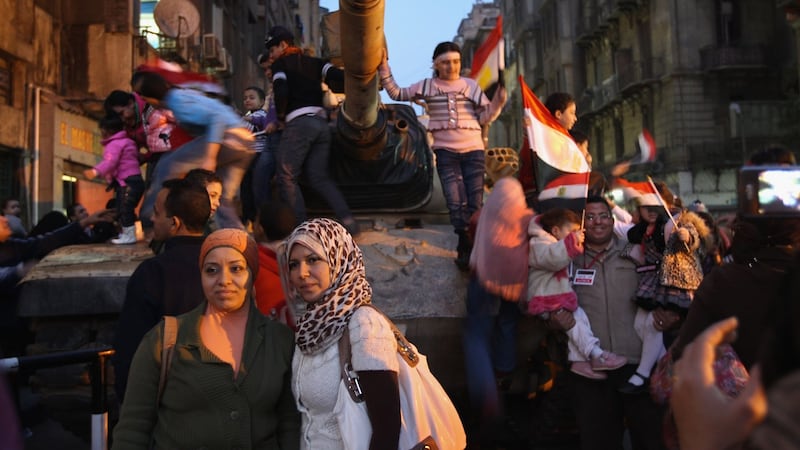"I participated in the January revolution," Egyptians have boasted on social media ahead of today, January 25th, the fifth anniversary of the first day of the 18-day mass uprising that drove 30-year president Hosni Mubarak from power.
They chatter on Twitter and Facebook, tools of the revolution, but they dare not mount mass celebratory demonstrations, banned by security forces and declared forbidden by Muslim clerics fearful of people power.
The joyous revolution brought together hundreds of thousands of Egyptians of all ages, walks of life, faiths and ethnicities in largely peaceful protests that could not be crushed by brute force although 845 died, hundreds were wounded, and thousands imprisoned.

The revolution had no leaders, only managers who arranged security and garbage collection and set up platforms where citizens had their say. Organiser Sherif, who formerly flew helicopters in Dublin, told The Irish Times they had expected 50, or at most 150 people, to turn up for the initial demonstration in Cairo's Tahrir (Liberation) Square: 50,000 came.
Across the Nile
They came on foot in phalanxes, from behind the square and across the Nile bridges leading to the square, chanting, “The people want the fall of the regime” and “Bread, freedom and justice”.
Their chants were carried around the world on satellite television screens and in newspaper print and echoed in the streets of Syria, Yemen, Bahrain, Saudi Arabia, Jordan, Libya and Lebanon. The veteran leaders of Yemen and Libya fell, precipitating civil conflict.
At a field hospital in a tent pitched on the traffic circle at the centre of Tahrir, a graphic designer calling himself Horus after the ancient Egyptian god, summed up the feelings of his countrymen: “This is the first time in 30 years we are proud to be Egyptians. We had become numb, we are surprised to take things into our own hands.”
Within months, however, the military men who had succeeded Mubarak after he stepped down on February 11th had taken back the reins of power – with the connivance of the country's largest political movement, the Muslim Brotherhood.
Founded in 1928 and repeatedly suppressed, the Brotherhood and other parties – fundamentalist, leftist and liberal – were set free by the uprising. The Brotherhood made the most of the liberation by fielding candidates for parliament, winning most seats, securing the election of president Mohamed Morsi, and rewriting the constitution to suit Brotherhood purposes.
The Brotherhood had no competition. The “revolutionaries” had no strategy for attaining their goals. Instead, they repeatedly took to the streets, creating an atmosphere of uncertainty and anarchy. They failed to coalesce into viable political parties and founded dozens of rival factions, internally divided by dissent. Respected figures such as Nobel laureate Mohamed El-Baradei, who founded the centrist Constitution Party and was briefly appointed vice-president, deserted in disappointment in 2013.
Army overhaul
Soon after his inauguration on June 30th, 2012, Morsi replaced senior army chiefs with younger men and made military intelligence head Abdel-Fattah al-Sisi overall commander.
In November, Morsi assumed extrajudicial powers to ensure the adoption of the new constitution by referendum, earning popular outrage and distrust. He failed to deliver the demands of the people as voiced during the uprising and stuffed the bureaucracy with Brotherhood loyalists.
"Million man" protests across Egypt on June 30th, 2013 led the military to topple him on July 3rd and appoint an interim government to prepare for fresh elections.
The Brotherhood responded with mass sit-ins in Cairo, marches, demonstrations, attacks on police and state institutions, to which the army and security forces replied with a harsh crackdown, killing more than 1,000 and imprisoning thousands. The Brotherhood’s radical allies stepped up attacks on troops, police and civilians in Sinai, intensifying the conflict.
The Brotherhood’s campaign backfired, alienating the majority of Egyptians. Vowing to restore order, Sisi easily won the May 2014 presidential election and pro-Sisi parties triumphed in last year’s parliamentary poll. Leftists, liberals and “heroes” of the uprising are being detained as well as Brotherhood members and sympathisers.
Egypt has not, however, reverted to square one. Today, the “revolution” remains a beacon to Egyptians who are no longer “numb” and still yearning for the “bread, freedom and justice” which seemed attainable in 2011.
















